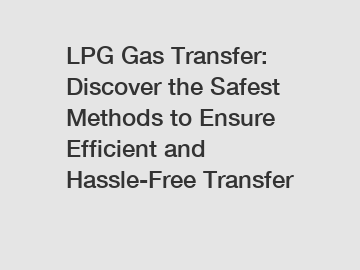LPG Gas Transfer: Discover the Safest Methods to Ensure Efficient and Hassle-Free Transfer
When it comes to LPG gas transfer, safety and efficiency are of paramount importance. Whether you are a homeowner, a commercial establishment, or a gas technician, it is crucial to be well-informed about the safest methods of transferring LPG gas. In this blog, we will delve into the best practices, guidelines, and innovative techniques that ensure a hassle-free transfer process. With years of experience in the industry, our expert team has compiled a comprehensive guide for you to follow.
1. Safety First: Understanding the Risks.
Before we explore the transfer methods, it is imperative to be aware of the risks associated with LPG gas transfer. LPG (Liquefied Petroleum Gas) is highly flammable and, if not handled properly, can cause serious accidents, including leaks, explosions, and fires. Therefore, it is vital to exercise caution and adhere to safety protocols at all times.

2. Mindful Handling: Guidelines for LPG Gas Transfer.
a. Proper Storage: Ensuring that LPG cylinders are stored upright, in a well-ventilated area, and away from any sources of ignition is the first step towards safe gas transfer. Regular inspections and maintenance of the storage areas are crucial to identify any potential risks.
b. Suitable Equipment: Use only industry-approved equipment to handle LPG gas transfer. This includes high-quality cylinders, regulators, hoses, and connectors. Regularly check for wear and tear, replace old parts, and maintain the equipment to prevent leakages.
c. Training and Qualifications: It is vital for anyone involved in the transfer process to receive proper training and certification. Gas technicians should possess relevant qualifications and be well-versed in the safety procedures to minimize the risks during transfer.
d. Protective Gear: Personal Protective Equipment (PPE) should be worn by anyone involved in LPG gas transfer. This includes gloves, goggles, fire-retardant clothing, and safety shoes. These measures provide an extra layer of protection against accidents.
3. Safe Transfer Techniques: Best Practices.
a. Bleeding the Cylinder: Before transferring gas from one cylinder to another, bleeding the cylinder is essential. This process involves releasing a small amount of gas to remove any air or impurities from the cylinder's valve.
b. Correct Cylinder Connections: Proper cylinder connections are crucial to prevent leaks. Ensure that the regulators, valves, and connectors are properly secured and tightened before initiating the transfer.
c. Slow and Steady Transfer: When transferring LPG gas, patience is key. The transfer should be done slowly and steadily to avoid pressure fluctuations that could cause leaks or accidents. Avoid sudden releases or fast transfers.
d. Valves and Regulator Monitoring: Throughout the transfer, closely monitor the valves and regulators for any irregularities or leakages. If any issues are detected, pause the transfer and address them before resuming.
4. Innovation and Technology: Ensuring Efficient Transfer.
a. Smart Metering Systems: Using advanced smart metering systems can significantly enhance the efficiency of LPG gas transfer. These automated systems measure and control the gas flow accurately and detect abnormalities, reducing human errors and improving overall safety.
b. Remote Monitoring: Remote monitoring systems equipped with sensors can detect leakages and irregularities in real-time, allowing prompt action to be taken. These systems provide an added layer of safety, particularly for large establishments or remote locations.
c. Robotics and Automation: Robotics and automation technologies are increasingly being used to streamline LPG gas transfer processes. These advanced systems minimize human intervention and rapidly detect and respond to any potential hazards, improving safety and efficiency.
Conclusion.
The safety of LPG gas transfer should never be compromised. By understanding the risks involved and following the guidelines and best practices outlined in this blog, you can ensure a smooth and secure transfer process. Additionally, embracing innovative technologies and incorporating them into your transfer practices can further enhance efficiency and mitigate risks. Remember, safety should always be the priority when working with LPG gas, and adherence to these methods will help create a safer environment for everyone involved.
If you are looking for more details, kindly visit hydraulic test pump, tank booster, pneumatic chemical injection pumps.
79
0
0

Comments
All Comments (0)